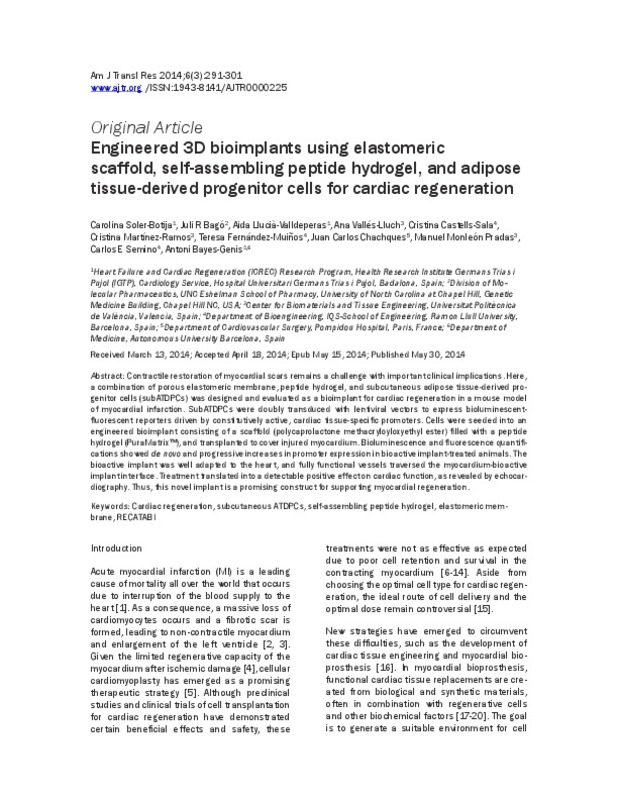JavaScript is disabled for your browser. Some features of this site may not work without it.
Buscar en RiuNet
Listar
Mi cuenta
Estadísticas
Ayuda RiuNet
Admin. UPV
Engineered 3D bioimplants using elastomeric scaffold, self-assembling peptide hydrogel, and adipose tissue-derived progenitor cells for cardiac regeneration
Mostrar el registro sencillo del ítem
Ficheros en el ítem
| dc.contributor.author | Soler-Botija, Carolina
|
es_ES |
| dc.contributor.author | Bago, Juli R.
|
es_ES |
| dc.contributor.author | Llucia-Valldeperas, Aida
|
es_ES |
| dc.contributor.author | Vallés Lluch, Ana
|
es_ES |
| dc.contributor.author | Castells-Sala, Cristina
|
es_ES |
| dc.contributor.author | Martinez-Ramos, Cristina
|
es_ES |
| dc.contributor.author | Fernandez-Muinos, Teresa
|
es_ES |
| dc.contributor.author | Chachques, Juan Carlos
|
es_ES |
| dc.contributor.author | Monleón Pradas, Manuel
|
es_ES |
| dc.contributor.author | Semino, Carlos E.
|
es_ES |
| dc.contributor.author | Bayes-Genis, Antoni
|
es_ES |
| dc.date.accessioned | 2016-05-12T07:39:19Z | |
| dc.date.available | 2016-05-12T07:39:19Z | |
| dc.date.issued | 2014 | |
| dc.identifier.issn | 1943-8141 | |
| dc.identifier.uri | http://hdl.handle.net/10251/63949 | |
| dc.description.abstract | [EN] Contractile restoration of myocardial scars remains a challenge with important clinical implications. Here, a combination of porous elastomeric membrane, peptide hydrogel, and subcutaneous adipose tissue-derived progenitor cells (subATDPCs) was designed and evaluated as a bioimplant for cardiac regeneration in a mouse model of myocardial infarction. SubATDPCs were doubly transduced with lentiviral vectors to express bioluminescent-fluorescent reporters driven by constitutively active, cardiac tissue-specific promoters. Cells were seeded into an engineered bioimplant consisting of a scaffold (polycaprolactone methacryloyloxyethyl ester) filled with a peptide hydrogel (PuraMatrix(TM)), and transplanted to cover injured myocardium. Bioluminescence and fluorescence quantifications showed de novo and progressive increases in promoter expression in bioactive implant-treated animals. The bioactive implant was well adapted to the heart, and fully functional vessels traversed the myocardium-bioactive implant interface. Treatment translated into a detectable positive effect on cardiac function, as revealed by echocardiography. Thus, this novel implant is a promising construct for supporting myocardial regeneration. | es_ES |
| dc.description.sponsorship | The research leading to these results received funding from the European Union Seventh Framework Programme (Project RECATABI, 7FP/2007-2013) under grant agreement number 229239. This work was also supported by Ministerio de Ciencia e Innovación (SAF2011- 30067-C02-01), Fundació La Marató de TV3 (080330), Red de Terapia Celular-TerCel (RD12/0019/0029), Red Cardio-vascular (RD12/0042/0047), Sociedad Española de Cardiología, and Fundació Privada Daniel Bravo Andreu | |
| dc.language | Inglés | es_ES |
| dc.publisher | e-Century Publishing | es_ES |
| dc.relation.ispartof | American Journal of Translational Research | es_ES |
| dc.rights | Reconocimiento - No comercial (by-nc) | es_ES |
| dc.subject | Cardiac regeneration | es_ES |
| dc.subject | Subcutaneous ATDPCs | es_ES |
| dc.subject | Self-assembling peptide hydrogel | es_ES |
| dc.subject | Elastomeric membrane | es_ES |
| dc.subject | RECATABI | es_ES |
| dc.subject.classification | MAQUINAS Y MOTORES TERMICOS | es_ES |
| dc.title | Engineered 3D bioimplants using elastomeric scaffold, self-assembling peptide hydrogel, and adipose tissue-derived progenitor cells for cardiac regeneration | es_ES |
| dc.type | Artículo | es_ES |
| dc.relation.projectID | info:eu-repo/grantAgreement/MICINN//SAF2011-30067-C02-01/ES/DESARROLLO DE BIOIMPLANTES PARA LA REGENERACION CARDIACA CON CELULAS PROGENITORAS DERIVADAS DE LA GRASA CARDIACA, BIOMATERIALES Y MONITORIZACION EN LINEA: EL "SMART PATCH"/ | es_ES |
| dc.relation.projectID | info:eu-repo/grantAgreement/EC/FP7/229239/EU/Regeneration of Cardiac Tissue Assisted by Bioactive Implants/ | |
| dc.relation.projectID | info:eu-repo/grantAgreement/Fundació La Marató de TV3//080330/ | es_ES |
| dc.relation.projectID | info:eu-repo/grantAgreement/MINECO//RD12%2F0019%2F0029/ES/Terapia Celular/ | es_ES |
| dc.relation.projectID | info:eu-repo/grantAgreement/MINECO//RD12%2F0042%2F0047/ES/Enfermedades cardiovasculares/ | es_ES |
| dc.rights.accessRights | Abierto | es_ES |
| dc.contributor.affiliation | Universitat Politècnica de València. Departamento de Termodinámica Aplicada - Departament de Termodinàmica Aplicada | es_ES |
| dc.contributor.affiliation | Universitat Politècnica de València. Centro de Biomateriales e Ingeniería Tisular - Centre de Biomaterials i Enginyeria Tissular | es_ES |
| dc.description.bibliographicCitation | Soler-Botija, C.; Bago, JR.; Llucia-Valldeperas, A.; Vallés Lluch, A.; Castells-Sala, C.; Martinez-Ramos, C.; Fernandez-Muinos, T.... (2014). Engineered 3D bioimplants using elastomeric scaffold, self-assembling peptide hydrogel, and adipose tissue-derived progenitor cells for cardiac regeneration. American Journal of Translational Research. 6:291-301. http://hdl.handle.net/10251/63949 | es_ES |
| dc.description.accrualMethod | S | es_ES |
| dc.relation.publisherversion | http://www.ajtr.org/ | |
| dc.description.upvformatpinicio | 291 | es_ES |
| dc.description.upvformatpfin | 301 | es_ES |
| dc.type.version | info:eu-repo/semantics/publishedVersion | es_ES |
| dc.description.volume | 6 | es_ES |
| dc.relation.senia | 279166 | es_ES |
| dc.identifier.pmid | 24936221 | |
| dc.identifier.pmcid | PMC4058310 | |
| dc.contributor.funder | European Commission | |
| dc.contributor.funder | Ministerio de Ciencia e Innovación | |
| dc.contributor.funder | Fundació La Marató de TV3 | |
| dc.contributor.funder | Ministerio de Economía y Competitividad | es_ES |






